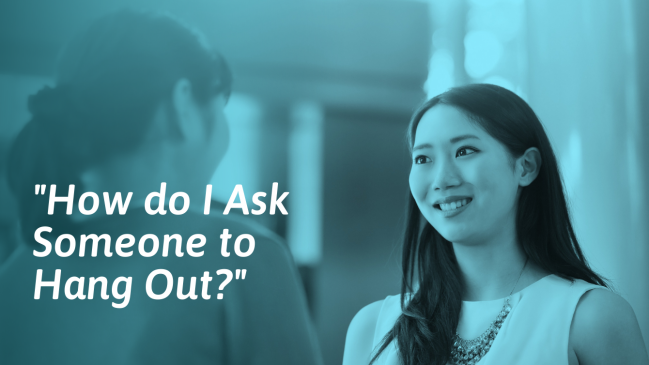“I’m trying to make some new friends but finding it really difficult. I don’t know how to invite someone to hang out without being awkward, and I’m worried I will seem needy, desperate, or annoying. How do I ask someone to hang out (not a date) without making things weird between us? ”
Most people find it really hard to make friends, especially as an adult. While inviting someone to hang out may give you a cringe-worthy feeling, it is a skill you will need to develop if you want to make friends with people you know at work, school, or other settings. This article will explain why inviting people out is so hard, things that might be making it more awkward, and 10 easy ways to ask people to hang out without making things weird.
Sections
- Why is it so hard to ask people to hang out?
- How to ask someone to hang out
- How to manage anxiety about asking someone out
Why is it so hard to ask people to hang out?
When you ask someone to hang out, you are being vulnerable and opening yourself up to the risk of rejection. Because you don’t know how the person will respond, your fears, insecurities, and negative thoughts may take over, trying to “help” you fill in the blanks. People who are very socially anxious and insecure have the hardest time with this because they expect that people will reject them.[1, 2]
The more insecure and anxious you are, the more likely it is that you will misinterpret social situations, seeing signs of rejection even when they aren’t there.[1, 2, 3] This can cause you to avoid, withdraw, and shut down, signaling to others that you are unapproachable. In this way, deep fears of rejection can trick people, creating a self-fulfilling prophecy.[3] By becoming more aware of your anxiety, you can often interrupt this and prevent it from happening.
How to ask someone to hang out
There are ways to ask someone to hang out that feel natural, comfortable, and easy instead of feeling awkward or forced. These 10 strategies can help you determine if there is mutual interest in hanging out and if so, take the next steps towards making plans.
1. Gauge their interest in hanging out with you
Not being sure if someone wants to hang out with you is probably one of the main reasons you are nervous about asking them. Testing the waters by saying, “We should hang out sometime,” or “Maybe we can get lunch one day” can give you a better read on whether the interest is mutual. Depending on how they respond, you can determine whether or not to make another, more direct attempt.
Remember that many people struggle with their own anxiety and insecurities, so getting a cool read on someone isn’t always a clear “no.” Your statement could have caught them off guard or triggered their own insecurities or fears. Once you take the initiative in suggesting the idea of getting together, they might feel more confident in following up later to make more concrete plans.
2. Gauge their interest in a specific activity
Another way to gauge a person’s interest in hanging out is by talking about a specific event or activity you are interested in and seeing if this sparks any enthusiasm. Saying, “I’m thinking about going to see the new Marvel movie this weekend” or, “Did you see that Hamilton is coming to town?” could open up this conversation.
If they perk up, ask questions, or express interest, you will feel more confident in asking them to join you. You can even gauge interest in an activity via text, social media or email by sharing a link and saying something like, “Did you see this?” or, “This looks fun!” and seeing how they respond.
3. Offer them an easy way to say no
You might be scared to ask someone to hang out because you don’t want them to feel pressured to say yes. By creating an “easy out” for them to decline if they aren’t interested or have other plans, you can reduce this anxiety and ensure that they say yes because they want to and not because they feel obligated to.
Try saying something like, “I’m having a party this weekend. You might already have plans, but if not, you are more than welcome to come!” or, “Do you have time to get lunch this week? I know you’re pretty swamped at work, so we can definitely take a rain check.” By keeping the invitation casual and giving them an easy way to say no or take a rain check, you can avoid making them feel pressured to accept your invitation.
4. Have a plan in mind
You might be so worried about someone saying “no” to hanging out that you haven’t considered what you will say or do if they say yes. In case they do, it is a good idea to have at least a tentative suggestion about where and when, as well as some activities of what you could do together.
That way, if they say, “Sure, when?” or “What did you have in mind?” you won’t be fumbling for ideas. Try to come up with a few activities or plans of what you could do, as well as identifying some possible days and times that work for you. This can also help relieve pressure on them to come up with ideas on the spot.
5. Nail down a day, time, and place
Sometimes general or open invitations result in no follow-through, even when both people really want to hang out. If this has happened, consider making your invitation more specific by nailing down the details. For instance, instead of saying, “We should get lunch one day,” you could say, “Would you like to get lunch on Friday?” or, “Do you want to check out that new bar with me after work tomorrow?”
By nailing down a more specific day, time, and place to hang out, you will avoid the continuous misses of, “We should hang out!” that never come to fruition. Even if they aren’t free, you will have opened the door to a more concrete plan, making it likely they will suggest an alternative day, time, or place to hang out.
6. Offer to help them with something
Sometimes, there will be an opportunity to offer to help someone with something they already have planned. For instance, if a coworker says they are moving in a couple of weeks, you could offer to lend a hand or let them borrow your truck. If they are working on a big project at work, you could offer to look over it for them and give them your ideas or feedback over lunch.
Offering to help people with things can be a great, low-stakes way to make plans with people. Because helping people generates positive feelings, you will feel good about offering, and they will probably appreciate it, even if they decline. Kindness, generosity, and service can go a long way towards generating trust, rapport, and friendship.
7. Ask to talk further over lunch or coffee
Sometimes, you can be very friendly with someone you know from work, school, or church, but might not know how to take these friendships into a new setting. If you find yourself having long conversations at the office or in the parking lot, consider asking to further the conversation over lunch or coffee. By doing so, you can often break the invisible barrier that keeps “work friends” or “church friends” from becoming real friends.
It’s often easy to approach this in a natural and casual way. For instance, you could say, “I’d really love to hear more about this. Maybe we could talk more over lunch?” or, “Any interest in walking down the street to Starbucks with me?” If now isn’t a good time, you could also defer to another day or time by saying, “I’d love to hear more about this. I’ve gotta run right now but are you free for lunch sometime next week?”
8. Invite them to contact you
Another way you can ask people to hang out without feeling awkward is to ping the ball in their court. For instance, offer your number and invite them to text or call you over the weekend if they want to hang out. You could also get more specific by saying something like, “I’m wide open on Saturday so call me if you want to get together.”
Creating this kind of open invitation lets people know you are interested in hanging out, as well as encouraging them to approach you. Healthy friendships are mutual and reciprocal, so don’t feel like you always have to be the one to initiate and make plans. While not everyone will take this cue, those who do are probably going to be the ones that are most interested in building a friendship with you.
9. Include them in your current plans
Another good way to ask someone to hang out without feeling awkward is to try to include them in your existing plans, rather than trying to come up with ideas of things to do. For instance, if you normally go to a certain yoga class, attend trivia on Thursdays with friends, or have a party at your house planned for this weekend, invite them to attend.
Letting them know what you are doing and that they are welcome to join can create an easy and casual way to ask them to hang out. This also relieves pressure on them to say yes because they know that the plan is not dependent on them accepting your invitation. Even if they aren’t able to join you, they will probably appreciate being invited and may even reciprocate by inviting you to hang out in the future.
10. Ask about their availability
Having a busy life, demanding work schedule, and many commitments can make it hard to have a social life, so pointed questions about dates and schedules are sometimes necessary to finalize plans. For example, asking, “What days are best for you next week?” or, “Do you have any free time this weekend?” can help pinpoint a person’s availability.
If your schedule is also pretty packed, you might need to narrow these questions even further by saying things like, “I’m free next Friday afternoon between 2-5 pm. Do you have any time then?” You may have to go back and forth a few times until you find a time that works for you both. While this approach may feel a bit formal, it is sometimes the only way busy people can maintain an active social life.
How to manage anxiety about asking someone out
What you do or don’t do when you feel insecure can determine how intense your anxiety gets, how long it lasts, and how much it impacts your interactions with other people. Some of the automatic responses and defenses you use when you feel anxious or insecure might actually be making it worse. Also called “safety behaviors,” these are common ways we try to appear more confident, hide our insecurities, and avoid rejection.[4, 5]
Examples of safety behaviors include staying quiet, rehearsing what you will say ahead of time, or putting on a show by faking confidence when you really feel insecure. Because these behaviors reinforce irrational beliefs and insecurities, they can make anxiety even worse.[4] You will have a much easier time approaching people and asking them to hang out if you are able to stop these behaviors and instead use some of the healthier methods listed below.[1, 3, 4, 5]
| What Makes Fear & Insecurity WORSE | What Makes Fear & Insecurity BETTER |
| Overthinking before, during & after talking to people
Repeating, ruminating, worrying, & analyzing thoughts |
Getting out of your head using mindfulness
Focusing on a task, your 5 senses, or the present moment |
| Self-criticism, replaying mistakes & flaws
Calling yourself awkward, beating yourself up |
Being kind and self-compassionate
Using positive affirmations, focus on strengths vs. flaws |
| Shutting down, staying quiet
Not chiming in or participating in conversations |
Speaking up, sharing ideas and opinions
Sharing ideas or input in meetings/conversation |
| Avoiding conversations and social activities
Avoiding small talk, declining invitations |
Regular exposure, practicing social skills
Weekly lunch dates, attending meetups, joining a club |
| Faking confidence, masking, using a persona
Trying too hard to fit in, entertain people, or be liked |
Being your authentic self
Being yourself, being different, saying what you think |
| Editing, rehearsing or censoring
Being overly cautious or intentional about what you say |
Trusting yourself to say the right thing
Being in the moment, using humor, loosening the filter |
| Assuming or expecting the worst
Replaying awkward or embarrassing moments |
Being present and open
Avoiding making assumptions and forming expectations |
| Being overly rigid, tense, or uptight
Trying to tightly control what you say or do |
Relaxing and letting go
Deep breaths, relaxing your posture, opening up |
| Focusing on making a good impression
Being distracted with self-conscious thoughts/worries |
Focusing on enjoying the conversation
Trying to experience and enjoy the conversation |
A good therapist can help you work on your safety behaviors.
We recommend BetterHelp for online therapy, since they offer unlimited messaging and a weekly session, and are cheaper than going to a therapist's office.
Their plans start at $64 per week. If you use this link, you get 20% off your first month at BetterHelp + a $50 coupon valid for any SocialSelf course: Click here to learn more about BetterHelp.
(To receive your $50 SocialSelf coupon, sign up with our link. Then, email BetterHelp’s order confirmation to us to receive your personal code. You can use this code for any of our courses.)
You may find it useful to read our guide on how to be less self-conscious.









Thank you so much for sharing this! The table on fear & insecurity and how to overcome it at the end was really helpful. Thank you very much to the author!